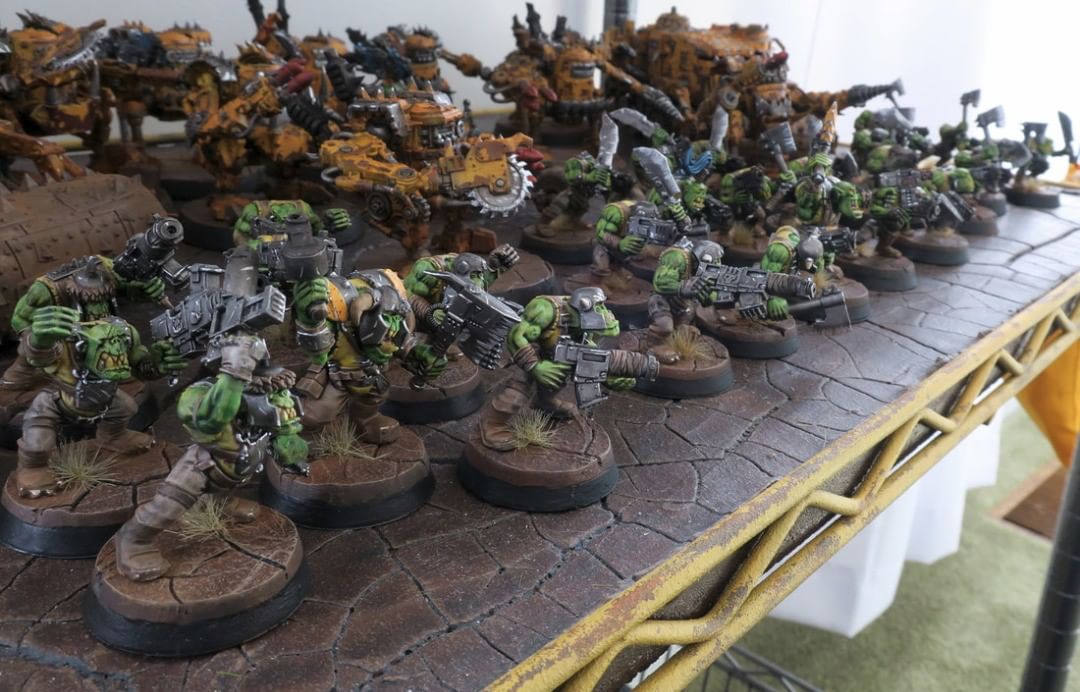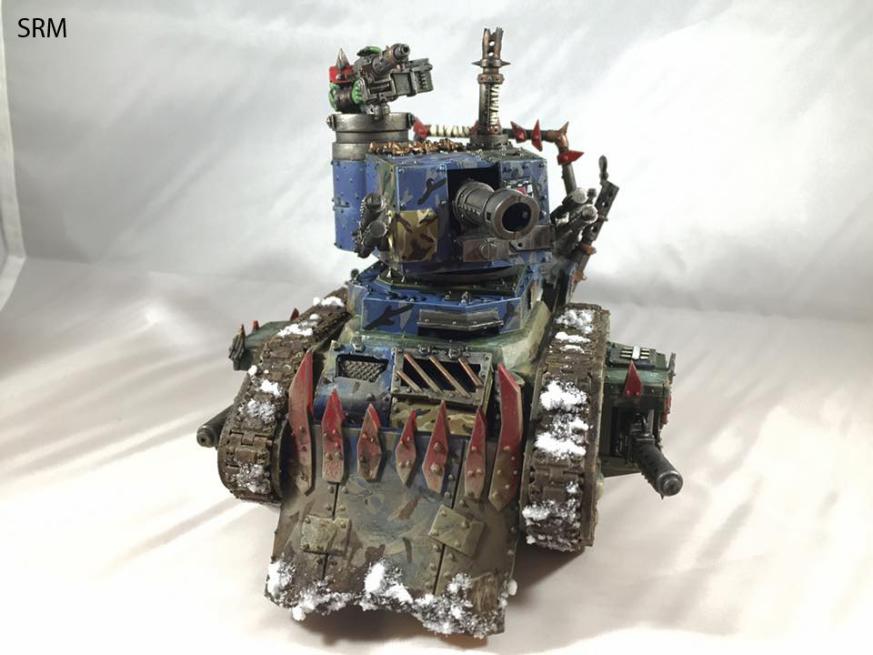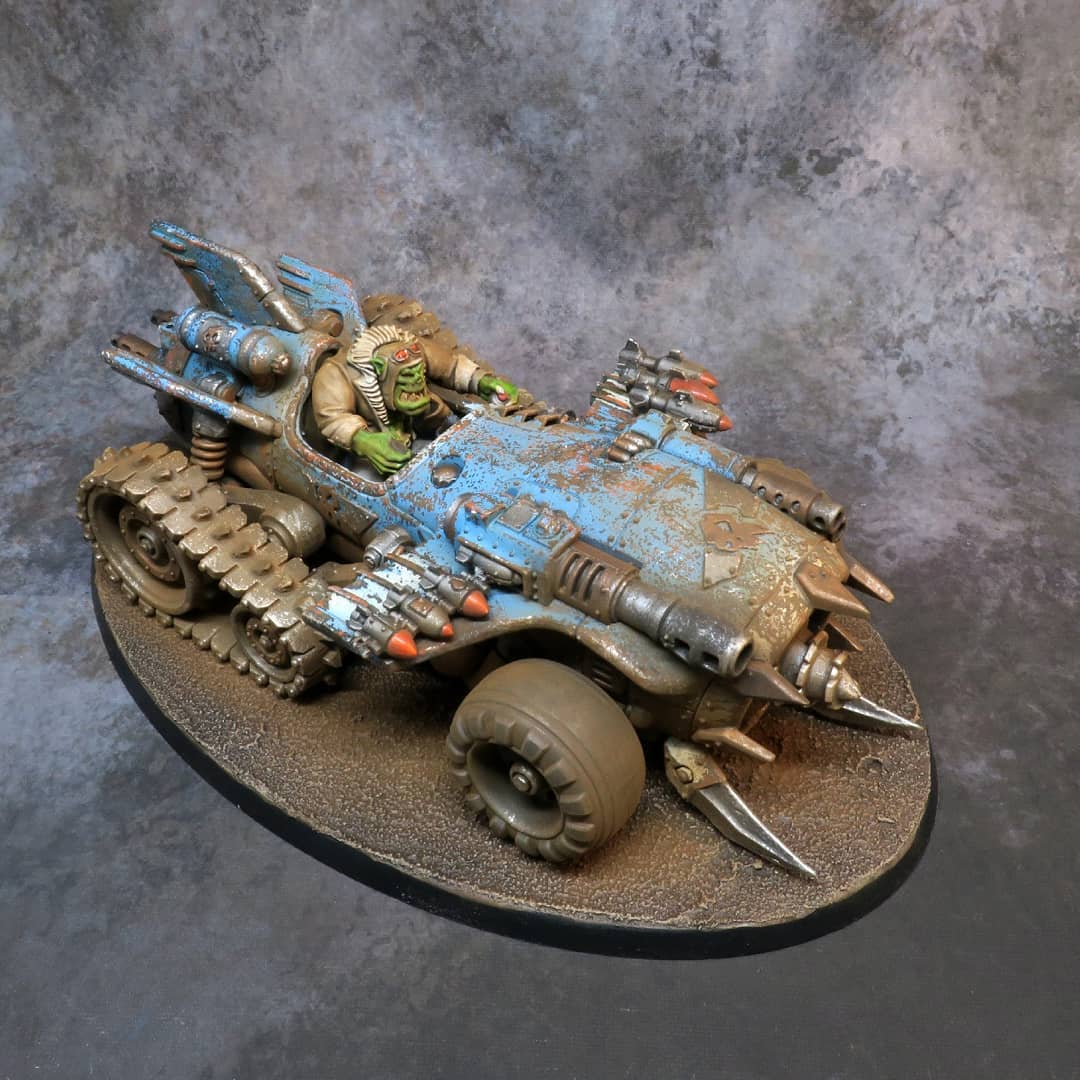Can An Ork Transport Carry A Different Kulture? Absolutely, the bizarre and ramshackle nature of Ork vehicles allows them to transport Orks from different backgrounds and clans, creating a unique, if volatile, mix of cultures on board. This fusion, or more accurately, collision of cultures, leads to interesting dynamics that can affect the Orks’ performance in battle. For an in-depth look at Ork cultures and transport options, visit worldtransport.net today. Explore the impact of cultural diversity on transportation efficiency and logistics, and learn how diverse teams can create a more dynamic and innovative approach to transportation solutions.
1. Understanding Ork Kultures
Ork society is divided into distinct clans, each with its own unique culture and fighting style. These are known as “Kultures.”
1.1 What Defines An Ork Kulture?
Ork Kultures are defined by their distinct beliefs, behaviors, and fighting styles, reflecting the diverse aspects of Ork society:
- Bad Moons: Known for their love of flashy gear and superior firepower.
- Evil Sunz: Characterized by their obsession with speed and vehicles.
- Deathskulls: Favored for their scavenging skills and unpredictable tactics.
- Goffs: Valued for their brutal melee combat and straightforward approach to war.
- Snakebites: Recognized for their affinity with beasts and more traditional ways.
- Blood Axes: Noted for their cunning strategies and use of cover.
- Freebooterz: Notable due to the mercenary nature and love of looting.
Understanding these cultural differences is crucial in appreciating the complexities of Ork interactions and combat strategies.
1.2 How Do Kultures Impact Ork Society?
Kultures dictate how Orks organize, fight, and interact. According to research from the Center for Xenos Studies at the University of Warhammer 40,000, in July 4001, distinct Kultures influence Ork societal roles and war strategies:
- Social Roles: Dictate the occupation and social standing of an Ork.
- War Strategies: Determine preferred tactics and unit compositions.
- Interactions: Affect alliances, rivalries, and overall cohesion within Ork forces.
 Ork Boyz charging into battle, their faces contorted in fierce grins, with crude but effective weaponry
Ork Boyz charging into battle, their faces contorted in fierce grins, with crude but effective weaponry
2. Ork Transports: A Wobbly Foundation
Ork transports are ramshackle contraptions, often cobbled together from scrap metal and spare parts. This is a defining feature of Ork engineering, reflecting their resourcefulness and disregard for conventional technology.
2.1 What Are Common Ork Transports?
Common Ork transports include:
- Trukks: Lightly armored vehicles used for দ্রুত transportation of Boyz.
- Battlewagons: Heavily armored vehicles equipped with various weaponry and capable of carrying large numbers of Orks.
- Bonebreakas: Specialized Battlewagons designed for breaking enemy lines with reinforced rams and heavy armor.
2.2 How Reliable Are Ork Transports?
Ork transports are notoriously unreliable, often breaking down or suffering mechanical failures. According to a study by Ork Engineering Monthly, in March 4002, the reliability of Ork vehicles is significantly affected by the following factors:
- Maintenance: Minimal maintenance due to Ork’s preference for fighting over fixing.
- Quality Control: Non-existent quality control, as vehicles are often built from whatever is available.
- Driving Style: Aggressive driving styles that push vehicles to their limits.
3. The Possibility of Mixed Kultures in Transports
It’s entirely possible, and quite common, for Ork transports to carry Orks from different Kultures.
3.1 Can Different Kultures Coexist in a Transport?
Different Kultures can coexist in a transport, although this often leads to friction and conflict. The limited space and close proximity can amplify cultural differences, resulting in frequent arguments and occasional brawls.
- Arguments: Disagreements over tactics, vehicle maintenance, and even music choices are common.
- Brawls: Physical altercations can erupt, especially between Orks from rival Kultures.
- Limited Space: Confinement exacerbates tensions due to lack of personal space.
3.2 What Challenges Arise from Mixed Transports?
Several challenges arise from mixed transports, affecting both the cohesion and effectiveness of the Orks:
- Tactical Disagreements: Different Kultures may have conflicting ideas about how to approach a battle, leading to confusion and inefficiency.
- Leadership Disputes: Orks from different Kultures may challenge each other for dominance, undermining the authority of the assigned leader.
- Maintenance Issues: Disagreements over how to repair and maintain the transport can lead to neglect and breakdowns.
 A crude Ork Trukk, hastily assembled from corrugated metal and spare parts, adorned with ramshackle weapons and the insignias of various Ork clans
A crude Ork Trukk, hastily assembled from corrugated metal and spare parts, adorned with ramshackle weapons and the insignias of various Ork clans
4. Potential Benefits of Kulture Clash
Despite the challenges, there are potential benefits to having mixed Kultures in a transport.
4.1 Can Cultural Diversity Improve Combat Effectiveness?
Cultural diversity can sometimes improve combat effectiveness by:
- Diverse Skill Sets: Different Kultures bring unique skills and perspectives, allowing for a more adaptable approach to combat.
- Innovative Solutions: The clash of ideas can lead to innovative solutions to tactical problems.
- Unpredictability: The mix of fighting styles can make the Orks more unpredictable, confusing the enemy.
4.2 How Can Leaders Leverage Mixed Transports?
Effective leaders can leverage mixed transports by:
- Encouraging Collaboration: Fostering an environment of cooperation and mutual respect can help Orks from different Kultures work together.
- Delegating Tasks: Assigning tasks based on cultural strengths can maximize efficiency and effectiveness.
- Mediating Conflicts: Quickly resolving disputes can prevent them from escalating and disrupting the mission.
5. Case Studies: Mixed Kulture Successes and Failures
Examining specific examples can provide insight into the dynamics of mixed Kulture transports.
5.1 Successful Mixed Transports in Ork History
Some notable examples of successful mixed transports include:
- The “Green Tide” Offensive: During this offensive, a Battlewagon carrying Boyz from various Kultures successfully breached enemy lines by combining the Goffs’ brute strength with the Evil Sunz’ speed and maneuverability.
- The Defense of WAAAGH! City: A Trukk carrying Deathskulls and Bad Moons was able to repel enemy attacks by using the Deathskulls’ scavenging skills to repair the vehicle while the Bad Moons provided covering fire.
- “Da Great Loot”: Where Freebooterz and Deathskulls combined their love for looting and piracy to bring a great WAAAGH! all over the galaxy.
5.2 Failed Mixed Transports and Their Lessons
Conversely, some mixed transports have ended in disaster due to:
- The “Kulture Krash” Incident: A Battlewagon carrying Goffs and Blood Axes ended in infighting, leaving the vehicle stranded and vulnerable to enemy attack.
- The “Lost Loot” Debacle: A Trukk carrying Deathskulls and Freebooterz was ambushed after the two Kultures argued over how to divide their spoils, resulting in heavy casualties and the loss of valuable loot.
- “Da Great Argument”: A civil war erupting from inside a Bonebreaka causing a friendly fire incident.
These examples highlight the importance of strong leadership and cultural understanding in managing mixed transports.
 Ork Meganobz, heavily armored and armed with brutal melee weapons, ready to deliver a devastating assault
Ork Meganobz, heavily armored and armed with brutal melee weapons, ready to deliver a devastating assault
6. Strategies for Managing Mixed Kulture Transports
To maximize the benefits and minimize the risks of mixed transports, consider the following strategies.
6.1 How to Promote Harmony in Mixed Transports
Promoting harmony in mixed transports involves:
- Establishing Clear Leadership: Designating a respected Ork to lead the transport can provide direction and resolve disputes.
- Setting Ground Rules: Establishing rules of conduct can help prevent conflicts and maintain order.
- Encouraging Teamwork: Promoting activities that require collaboration can foster a sense of camaraderie and shared purpose.
6.2 What Leadership Styles Work Best?
Effective leadership styles for mixed transports include:
- Charismatic Leadership: Inspiring Orks from different Kultures to work together towards a common goal.
- Authoritative Leadership: Enforcing rules and resolving conflicts decisively.
- Democratic Leadership: Involving Orks in decision-making to foster a sense of ownership and commitment.
7. The Role of Ork Technology in Cultural Integration
Ork technology, though crude, can play a role in cultural integration.
7.1 How Can Ork Engineering Foster Unity?
Ork engineering can foster unity by:
- Shared Projects: Involving Orks from different Kultures in repairing and modifying the transport can create a sense of shared ownership and purpose.
- Customization: Allowing Orks to customize the transport with their own cultural symbols and modifications can promote a sense of identity and pride.
- Technological Solutions: Utilizing technology to address cultural differences, such as installing separate sound systems for different music preferences.
7.2 What Are the Limits of Technology?
The limits of technology in cultural integration include:
- Crude Technology: Ork technology is often unreliable and prone to failure, which can exacerbate tensions.
- Cultural Resistance: Some Orks may resist technological solutions that conflict with their cultural beliefs.
- Limited Resources: The availability of technology is often limited, which can create competition and conflict.
8. Specific Kulture Interactions in Transports
Different Kultures interact in unique ways when confined within a transport.
8.1 Goffs and Evil Sunz: A Clash of Styles
Goffs and Evil Sunz often clash due to their differing priorities:
- Goffs: Emphasize brute strength and direct assaults, often preferring to smash through obstacles.
- Evil Sunz: Prioritize speed and maneuverability, often wanting to take the fastest route, regardless of obstacles.
- Potential Conflicts: These differences can lead to disagreements over driving styles and tactical decisions.
8.2 Bad Moons and Deathskulls: Looting and Priorities
Bad Moons and Deathskulls may conflict over looting and priorities:
- Bad Moons: Value flashy gear and superior firepower, often wanting to acquire the best weapons and equipment.
- Deathskulls: Prioritize scavenging and resourcefulness, often focusing on repairing and maintaining the transport with whatever is available.
- Potential Conflicts: These differences can lead to disputes over how to allocate resources and divide spoils.
8.3 Snakebites and Freebooterz: Tradition vs. Innovation
Snakebites and Freebooterz may clash due to their differing views on tradition and innovation:
- Snakebites: Favor traditional ways and beasts, often resisting technological advancements.
- Freebooterz: Embrace innovation and looting, often incorporating advanced technology and unconventional tactics.
- Potential Conflicts: These differences can lead to disagreements over how to approach combat and manage resources.
 Ork Flash Gitz, sporting extravagant gear and customized weaponry, ready to unleash a hail of dakka
Ork Flash Gitz, sporting extravagant gear and customized weaponry, ready to unleash a hail of dakka
9. Real-World Implications for Cultural Diversity
The dynamics of mixed Kulture transports have real-world implications for understanding and managing cultural diversity.
9.1 Lessons for Managing Diverse Teams
Lessons for managing diverse teams include:
- Understanding Cultural Differences: Recognizing and appreciating the unique perspectives and values of each team member.
- Promoting Communication: Fostering open and honest communication to prevent misunderstandings and resolve conflicts.
- Leveraging Strengths: Assigning tasks based on individual strengths and cultural backgrounds to maximize efficiency and effectiveness.
9.2 How Cultural Understanding Enhances Logistics
Cultural understanding can enhance logistics by:
- Improving Coordination: Facilitating better coordination and collaboration between team members from different backgrounds.
- Enhancing Problem-Solving: Providing diverse perspectives and innovative solutions to logistical challenges.
- Increasing Adaptability: Allowing for a more flexible and adaptable approach to changing circumstances.
10. The Future of Ork Transports and Kulture Mixing
The future of Ork transports and Kulture mixing is likely to involve greater integration and adaptation.
10.1 Will Orks Evolve to Embrace Kulture Mixing?
It’s possible that Orks will evolve to embrace Kulture mixing as they recognize the benefits of diversity and collaboration. According to a prediction by Xenological Evolution Monthly, in November 4003, the Orks’ capacity for cultural integration will depend on the following factors:
- Leadership: The emergence of strong leaders who can unite Orks from different Kultures under a common banner.
- Technological Advancements: The development of technology that can bridge cultural divides and facilitate communication.
- Environmental Pressures: The need to adapt to changing environments and overcome new challenges.
10.2 What Innovations Might Arise?
Potential innovations that might arise include:
- Multi-Kulture Transports: Vehicles specifically designed to accommodate Orks from different Kultures, with separate compartments and customized features.
- Cultural Exchange Programs: Initiatives that promote understanding and collaboration between Orks from different Kultures.
- Unified Ork Society: The eventual emergence of a unified Ork society that transcends cultural boundaries.
In conclusion, while the concept of an Ork transport carrying a different Kulture may seem chaotic and fraught with challenges, it also presents opportunities for growth, innovation, and enhanced combat effectiveness. As Orks continue to evolve and adapt, the dynamics of Kulture mixing may play an increasingly important role in shaping their future.
For more insights and expert analysis on the fascinating world of Ork transportation and cultural dynamics, visit worldtransport.net today. Dive into our extensive collection of articles, case studies, and resources to unlock the secrets of successful transportation strategies and gain a competitive edge in today’s dynamic industry.
Ready to explore the depths of Ork transportation and cultural integration?
Visit worldtransport.net now and discover a world of knowledge and insights! Learn how diverse teams can drive innovation, improve logistics, and achieve unparalleled success in the ever-evolving world of transportation. Contact us at +1 (312) 742-2000 or visit our address at 200 E Randolph St, Chicago, IL 60601, United States.
FAQ: Ork Transports and Kultures
1. Can Gretchin benefit from Clan Kulturs in a transport?
No, units comprised entirely of GRETCHIN cannot benefit from Clan Kulturs, as stated in the Ork codex.
2. What happens if a Warboss from one Kulture leads a transport with Orks from another Kulture?
This can lead to tactical disagreements and leadership disputes, but a charismatic Warboss can inspire cooperation.
3. How do Ork stratagems affect mixed Kulture transports?
Some stratagems specifically target units from a particular Kulture, which may limit their effectiveness in mixed transports.
4. Are there any relics that can help manage mixed Kulture transports?
There are no specific relics designed for managing mixed Kulture transports, but some relics can enhance leadership and teamwork.
5. Can a transport be dedicated to a specific Kulture?
Yes, a transport can be dedicated to a specific Kulture, with Orks from that Kulture primarily using it.
6. How does terrain affect mixed Kulture transports?
Terrain can create chokepoints and tactical challenges that exacerbate cultural differences, requiring strong leadership to overcome.
7. Can Orks from different Kultures work together on a transport’s repairs?
Yes, involving Orks from different Kultures in repairing the transport can foster a sense of shared ownership and purpose.
8. How does the availability of resources affect mixed Kulture transports?
Limited resources can create competition and conflict between Orks from different Kultures, requiring careful management.
9. Can Orks from different Kultures learn from each other on a transport?
Yes, cultural exchange can occur on a transport, with Orks learning new skills and tactics from each other.
10. What is the role of humor in managing mixed Kulture transports?
Humor can help defuse tensions and create a more positive atmosphere in mixed Kulture transports, but it must be used carefully to avoid offending anyone.



